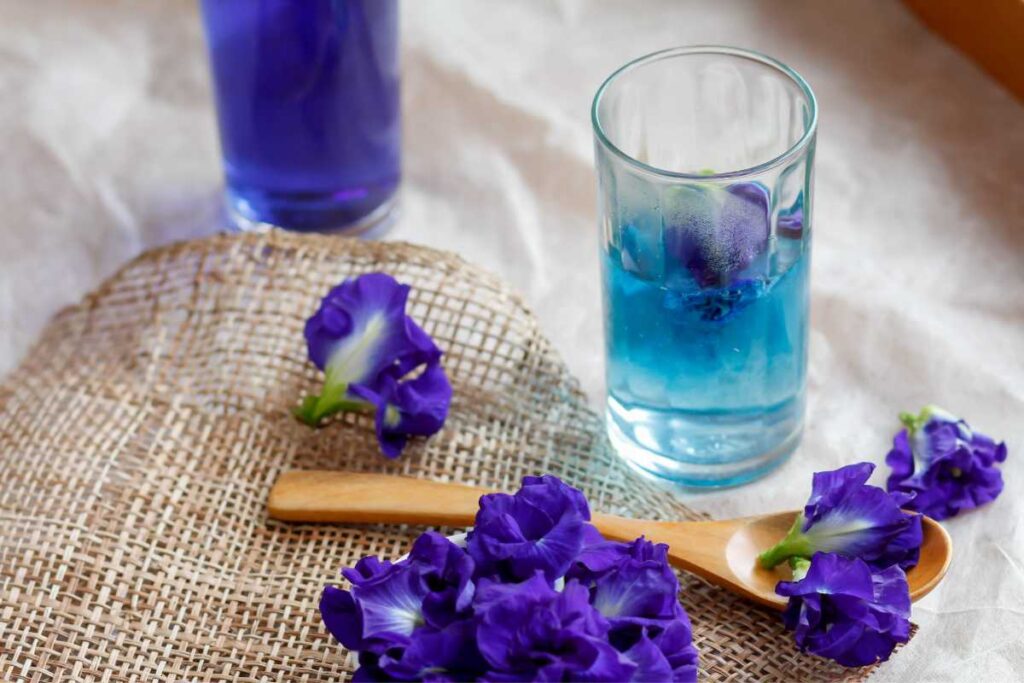11 Benefits of Butterfly Pea Flower Tea

Butterfly pea flower, scientifically known as Clitoria ternatea, is a beautiful blue flower native to Southeast Asia. This flower has been used in traditional medicine and cooking for centuries due to its potential health benefits and vibrant color. Butterfly pea flowers are also known by other names such as blue butterfly pea, blue pea, cordofan pea, or ternatea flowers.
The bright blue color of butterfly pea flowers makes them a popular ingredient for natural food and drink coloring. The flowers contain antioxidants that may help reduce inflammation and improve cognitive function. Moreover, butterfly pea flowers have a neutral pH level which makes them ideal ingredients for both acidic and alkaline recipes.
Butterfly pea flowers can be used in many ways in the kitchen. They can be steeped in hot water to make tea or added to cocktails for a pop of color. The tea made from butterfly pea flowers is not only visually appealing but also has a delicate floral flavor with earthy undertones. The dried butterfly pea flowers can be ground into powder form and used as an ingredient in baking recipes like cakes or bread.
Apart from its use in the culinary world, butterfly pea flowers are also used in cosmetics and hair care products due to their nourishing properties. The extract from these beautiful blue blooms contains flavonoids that help protect hair from damage caused by free radicals while promoting healthy hair growth.
To conclude this brief introduction about butterfly pea flower: it’s an incredibly versatile ingredient with numerous potential health benefits that can be enjoyed both internally and externally. Whether you’re looking to add some natural color to your food or drink recipes or reap the nourishing benefits of this incredible plant extract on your skin or hair – there are endless possibilities when it comes to using butterfly pea flower!
Benefits of Consuming Butterfly Pea Flower
Rich in Antioxidants
Butterfly pea flower is a natural source of antioxidants, which are beneficial for overall health. Antioxidants help to fight free radicals that can cause cell damage and lead to various diseases such as cancer, heart disease, and Alzheimer’s. The butterfly pea flower contains flavonoids, anthocyanins, and phenolic compounds that have potent antioxidant properties.
Studies have shown that consuming butterfly pea flower tea can increase antioxidant activity in the body. One study found that drinking butterfly pea flower tea for four weeks increased antioxidant levels in healthy adults. Another study showed that the antioxidants in butterfly pea flowers helped protect liver cells from damage caused by toxins.
May Help Improve Cognitive Function
The butterfly pea flower has been traditionally used for centuries to improve cognitive function. Recent studies have shown that it may indeed have cognitive benefits due to its high content of flavonoids and anthocyanins.
One study found that consuming a beverage containing butterfly pea flower extract improved cognitive function in older adults with mild cognitive impairment. Another study showed that the extract had memory-enhancing effects on rats.
Can Aid in Reducing Stress and Anxiety
Butterfly pea flower has been used traditionally as a natural remedy for reducing stress and anxiety. Modern research has confirmed its anxiolytic properties.
A study conducted on human subjects showed that drinking butterfly pea flower tea reduced anxiety levels significantly compared to a placebo group. Another animal study showed similar results, where rats treated with the extract exhibited less anxious behavior compared to untreated rats.
May Have Anti-inflammatory Properties
Inflammation is a natural response of the immune system to injury or infection. However, chronic inflammation can lead to various diseases such as arthritis, heart disease, and cancer. The anti-inflammatory properties of butterfly pea flowers may help prevent these conditions.
One animal study found that administering butterfly pea flower extract reduced inflammation markers in rats with induced arthritis. Another study demonstrated similar results when treating rats with induced colitis.
Can Help Improve Skin Health
Butterfly pea flower has been used traditionally to improve skin health and prevent premature aging. The high content of antioxidants in the flower may help protect the skin from damage caused by free radicals.
One study found that applying a cream containing butterfly pea flower extract reduced wrinkles and improved skin elasticity in human subjects. Another study showed that the extract had UV-protective effects on rat skin cells.
May Aid in Digestion
The butterfly pea flower has been traditionally used as a natural remedy for digestive issues such as constipation and bloating. Modern research has shown that it may indeed have beneficial effects on digestion due to its high content of flavonoids.
One animal study found that administering butterfly pea flower extract increased gut motility and reduced constipation in rats. Another study showed that the extract had protective effects on gastric ulcers in rats.
Butterfly Pea Tea: History and Culture
South East Asia has a rich history of traditional herbal teas, with butterfly pea tea being one of the most popular. Made from steeping dried butterfly pea flowers in hot water, this vibrant blue-colored beverage has been consumed for centuries in countries like Thailand, Malaysia, and Vietnam. In recent years, butterfly pea flower tea has gained popularity beyond its cultural roots and become a trendy drink in the Western world.
Blue Butterfly Pea Flower Tea
The striking blue color of butterfly pea tea is what makes it stand out from other herbal teas. The blue color comes from anthocyanin pigments found naturally in the flowers. When steeped in hot water, these pigments are released and create a deep blue hue that is both visually appealing and unique.
Beyond its aesthetic appeal, butterfly pea tea is also known for its potential health benefits. It is said to be high in antioxidants and flavonoids that can help protect against cellular damage caused by free radicals. Some studies suggest that it may have anti-inflammatory properties that could help reduce inflammation throughout the body.
Herbal Tea
While butterfly pea tea is commonly consumed on its own as an herbal tea, it can also be mixed with other ingredients to create unique flavor combinations. In South East Asia, it is often mixed with honey or lemon juice to add sweetness or tartness to the drink. In the Western world, bartenders have begun using it as a natural food coloring agent for cocktails and other beverages.
Green Tea
For those who enjoy green tea but want to try something new, mixing butterfly pea flower with green tea creates a blend that combines the flavor and health benefits of both drinks. Green tea is known for its high levels of antioxidants and catechins which have been linked to improved brain function and reduced risk of chronic diseases such as cancer.
How to Make Butterfly Pea Tea
Boil Water in a Pot or Kettle
To make butterfly pea flower tea, the first step is to boil water in a pot or kettle. You can use tap water or filtered water, whichever you prefer. Make sure to use enough water for the amount of tea you want to make.
Add Dried Butterfly Pea Flowers to the Water and Let it Steep for 5-10 Minutes
Once the water has boiled, add dried butterfly pea flowers to it and let it steep for 5-10 minutes. The amount of flowers you use will depend on how strong you want your tea to be. Generally, one tablespoon of dried butterfly pea flowers per cup of water is a good ratio.
While steeping, the color of the water will change from clear to blue as the pigments from the butterfly pea flowers are released into the hot water. This natural color change makes butterfly pea flower tea a popular choice for Instagram-worthy pictures.
Strain the Tea Into a Cup or Teapot
After steeping, strain the tea into a cup or teapot using a fine mesh strainer or cheesecloth. This will remove any leftover bits of flower that may have fallen into your tea while brewing.
Add Honey, Lemon, or Other Sweeteners to Taste
Butterfly pea flower tea has an earthy taste that some people find bitter. To sweeten it up, consider adding honey, lemon juice, sugar, or other sweeteners according to your preference. Some people also like adding ginger slices for additional flavor.
How to Make Hot Butterfly Pea Tea:
Hot butterfly pea flower tea is perfect for cold winter days when you need something warm and comforting. Simply follow the steps above and enjoy!
How to Make Iced Butterfly Pea Tea:
Iced butterfly pea flower tea is refreshing and perfect for hot summer days. Once brewed and strained according to instructions above, let it cool down before pouring over ice. You can also add a slice of lemon or lime for extra tanginess.
How to Make Butterfly Pea Tea Taste Good:
If you find the taste of butterfly pea flower tea too strong, try adding more sweeteners like honey or sugar. You can also mix it with other teas like green tea or mint tea to balance out the flavors.
How to Drink Butterfly Pea Flower Tea:
Butterfly pea flower tea can be enjoyed hot or iced, depending on your preference. It’s a great alternative to coffee and black tea, especially if you’re looking for something caffeine-free. Butterfly pea flower is known for its health benefits such as improving skin health and reducing stress levels.
Different Variations of Butterfly Pea Tea Recipes
Hot or Cold, Sweetened or Unsweetened: Different Variations of Butterfly Pea Tea Recipes
Butterfly pea flower tea is a versatile drink that can be consumed in various ways. You can enjoy it hot or cold, sweetened or unsweetened, and with or without milk. The taste of the tea is mild and earthy with a slightly sweet aftertaste.
To make butterfly pea flower tea, you will need dried butterfly pea flowers and a tea strainer. Simply steep the flowers in hot water for several minutes using the strainer to remove any loose petals. The longer you steep the flowers, the darker blue the color of your tea will be.
If you want to try something unique, mix your butterfly pea flower tea with milk to create a vibrant blue latte. This visually stunning drink is not only beautiful but also delicious. You can use any type of milk such as almond milk, soy milk, or regular cow’s milk depending on your preference.
Adding Lemon Juice or Honey: Other Variations of Butterfly Pea Flower Tea Recipes
While butterfly pea flower tea is delicious on its own, adding lemon juice or honey can enhance its flavor and provide additional health benefits. Lemon juice adds a citrusy tang to the mild flavor of the tea while also providing vitamin C and antioxidants that are great for your immune system.
Honey is another great addition to butterfly pea flower tea as it adds natural sweetness without overpowering the delicate taste of the flowers. Honey has antibacterial properties that may help soothe sore throats and boost overall health.
Growing and Caring for Butterfly Pea Plant
Butterfly pea plants are a beautiful addition to any garden or balcony, with their vibrant blue flowers adding a pop of color wherever they grow. These hardy plants thrive in warm zones and can be grown in pots or in the ground, making them a versatile choice for gardeners of all levels. In this section, we will discuss how to grow and care for butterfly pea plants.
Planting Butterfly Pea Plants
The first step in growing butterfly pea plants is to choose the right location. These plants require well-draining soil and regular watering to keep their roots healthy, so it’s important to select an area that receives plenty of sunlight but also has good drainage. If you’re planting your butterfly pea plant in a pot, make sure it has adequate drainage holes and use a high-quality potting mix.
When planting your butterfly pea plant, dig a hole that is slightly larger than the root ball and gently loosen the roots before placing the plant in the hole. Backfill with soil and water thoroughly, making sure that the soil is moist but not waterlogged.
Caring for Butterfly Pea Plants
Once your butterfly pea plant is established, it’s important to take proper care of it to ensure healthy growth and abundant blooms. Regular pruning is essential to prevent these plants from becoming too leggy and encourage new growth. Prune back any dead or damaged branches as well as any shoots that are growing out of bounds.
In addition to pruning, make sure your butterfly pea plant receives regular waterings during dry periods. These plants prefer consistently moist soil but can become stressed if overwatered or left in standing water for extended periods.
Harvesting Edible Peas
One unique feature of butterfly pea plants is their edible peas which are commonly used in traditional Southeast Asian cuisine. To harvest these peas, wait until they have fully matured on the vine before picking them off. The peas can be eaten raw or cooked and are often used to add color and flavor to dishes such as rice, tea, and desserts.
Water, Humidity, Temperature: The Key Factors for Growing Butterfly Pea Flower
Consistent Watering is Key
To ensure that your butterfly pea flower thrives, consistent watering is essential. The plant requires moist soil, but not too much water to avoid root rot. It’s important to keep the soil consistently moist, but not waterlogged. Overwatering can lead to yellow leaves and stunted growth.
One way to ensure proper watering is to use a moisture meter. This handy tool will indicate when it’s time to water the plant by measuring the moisture levels in the soil. You can also check the soil manually by sticking your finger about an inch deep into the soil; if it feels dry, it’s time to water.
Ideal Humidity Level
Butterfly pea flower prefers a humidity level between 50-60%. If you live in an area with low humidity, you may want to consider using a humidifier or placing a tray of water near the plant for added moisture.
It’s also important to note that high humidity levels can lead to fungal diseases such as powdery mildew. To prevent this from happening, make sure there is proper air circulation around the plant and avoid getting water on the leaves.
Well-Draining Soil with Optimal pH Level
Butterfly pea flower prefers well-draining soil with a pH level between 5.5-6.5. The ideal mix for planting butterfly pea flower includes one part peat moss, one part perlite or vermiculite, and one part potting soil.
If you’re unsure about your soil’s pH level, you can purchase a test kit at your local garden center or online. Adjusting the pH level may be necessary if it falls outside of the optimal range; adding lime will raise the pH level while sulfur will lower it.
Using Hot Water for Extraction
The blue pigment found in butterfly pea flowers can be extracted using hot water without damaging the plant. However, boiling water should be avoided as it can cause the flowers to lose their color and damage the plant.
To extract the blue pigment, simply pour hot water over the flowers and let them steep for a few minutes. The longer you steep, the deeper the blue color will be. Adding sugar to the mixture can enhance the flavor and sweetness of the resulting tea.
Warm Environment with Adequate Sunlight
Butterfly pea flower should be kept in a warm environment with temperatures between 70-85°F. If you live in an area with cooler temperatures, consider growing your plant indoors or using a greenhouse.
The plant requires at least 6 inches of sunlight per day, so make sure to place it in an area that receives adequate sunlight. If you’re growing your butterfly pea flower indoors, consider using grow lights to ensure proper lighting.
Common Pests, Diseases, and Care for Butterfly Pea Plants
Susceptibility to Fungal Diseases
Butterfly pea plants are prone to fungal diseases, such as powdery mildew, leaf spot, and root rot. Powdery mildew is characterized by the appearance of white or gray powdery spots on the leaves and stems, while leaf spot causes brown or black spots on the foliage. Root rot is caused by overwatering and poor soil drainage, leading to decay of the plant’s roots.
To prevent these diseases from affecting butterfly pea plants, it is important to plant them in well-draining soil that allows excess water to drain away. Overwatering should be avoided as it can lead to root rot. Proper air circulation around the plants can help prevent fungal growth. If fungal diseases do occur despite these precautions, affected areas should be removed immediately and disposed of properly.
Common Pests
Aphids and spider mites are common pests that can infest butterfly pea plants. Aphids are small insects that feed on the sap of plants and can cause stunted growth and curled leaves. Spider mites are tiny arachnids that also feed on plant sap and produce webbing around affected areas.
Regularly inspecting butterfly pea plants for signs of pest infestation is crucial for early detection and control. Insecticidal soap or neem oil can be used to effectively control both aphids and spider mites without harming beneficial insects like bees and ladybugs.
Proper Care
Proper care for butterfly pea plants includes regular pruning to promote healthy growth and remove any dead or diseased plant material. Pruning encourages new growth while preventing overcrowding that can lead to fungal diseases.
Butterfly pea plants require full sun exposure for optimal growth but may benefit from partial shade during hot summer months. They prefer well-draining soil with a slightly acidic pH level between 5.5-6.5.
Risks and Side Effects of Using Butterfly Pea Flower
Possible Side Effects of Using Butterfly Pea Flower
While butterfly pea flower has been used for centuries in traditional medicine and cuisine, it is important to note that there are possible side effects associated with its use. Some people may experience adverse reactions, especially if they consume large amounts or have pre-existing medical conditions.
One of the most common side effects of butterfly pea flower consumption is gastrointestinal discomfort. This includes symptoms such as nausea, bloating, and diarrhea. These symptoms can be mild to severe depending on the individual and the amount consumed.
Another potential side effect of consuming butterfly pea flower is allergic reactions. Some people may develop an allergic reaction to the plant, which can cause symptoms such as itching, hives, and difficulty breathing. If you experience any of these symptoms after consuming butterfly pea flower, seek medical attention immediately.
Interactions with Medications
Butterfly pea flower may also interact with certain medications. For example, it can lower blood pressure and should be avoided by individuals taking medications for hypertension or those undergoing surgery. It may interfere with blood clotting medications and should not be consumed by those taking anticoagulants.
Not Recommended for Pregnant or Breastfeeding Women
If you are pregnant or breastfeeding, it is recommended that you avoid consuming butterfly pea flowers due to a lack of research on their safety during pregnancy and lactation. While there have been no reported adverse effects in pregnant women who have consumed the plant in small amounts, it is better to err on the side of caution.
Overconsumption May Lead to Adverse Effects
Like many other natural remedies and supplements, overconsumption of butterfly pea flowers can lead to adverse effects. Consuming too much butterfly pea flower tea or extract may cause headaches, dizziness, or even hallucinations in some individuals.
It is important to note that while there are potential risks associated with using butterfly pea flowers, these risks are generally low when consumed in moderation. As with any supplement or natural remedy, it is important to speak with your healthcare provider before adding butterfly pea flower to your regimen.
Embrace the Beauty and Health Benefits of Butterfly Pea Flower
As you have learned, butterfly pea flower is not just a pretty flower. It has numerous benefits for your health and well-being. From its antioxidant properties to its ability to reduce stress and anxiety, this flower has a lot to offer.
Butterfly pea tea, made from the dried flowers, is not only delicious but also rich in antioxidants and anti-inflammatory compounds that can help improve your overall health. You can enjoy it hot or cold, with honey or lemon, or even mixed with other herbs and spices for a unique flavor experience.
If you’re interested in growing butterfly pea plants at home, remember that they require specific conditions to thrive. Adequate water, humidity, and temperature are key factors to keep in mind when caring for these plants. However, with proper care and attention, you can enjoy the beauty of their vibrant blue flowers all year round.
It’s important to note that while butterfly pea flower is generally safe for consumption and use in skincare products, there are some risks and side effects associated with its use. Always consult with a healthcare professional before using any new herb or supplement.




